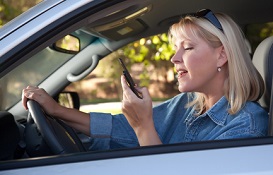 A ruling handed down in California last month should be noted by addicted-to-the-Internet drivers (aka all Californians).
A ruling handed down in California last month should be noted by addicted-to-the-Internet drivers (aka all Californians).
An appeals court judge set tighter restrictions on drivers’ use of cell phones, siding with a police citation levied against Steven Spriggs for looking at Google Maps directions while behind the wheel.
Hands on the Wheel
In his court trial in 2012, Spriggs and Jack Graham, the California Highway Patrol officer who cited him, testified that Spriggs used his hands to check directions on his smartphone while driving — it proved to be Spriggs’ undoing.
According to the decision, the appellate court was faced with “an ambiguity” as to whether or not use of a cell phone for Google Maps was subject to the state’s distracted driving law barring use of hand-held devices, which states:
“A person shall not drive a motor vehicle while using a wireless telephone unless that telephone is specifically designed and configured to allow hands-free listening and talking, and is used in that manner while driving.”
The takeaway for Judge W. Kent Hamlin: hands on the wheel.
“Our review of the statute’s plain language leads us to conclude that the primary evil sought to be avoided is the distraction the driver faces when using his or her hands to operate the phone,” Hamlin wrote. “That distraction would be present whether the wireless telephone was being used as a telephone, a GPS navigator, a clock or a device for sending and receiving text messages and emails.”
In Hamlin’s ruling, the judge said that the hands-free law targeted the use of hands that some devices require, leaving aside those devices’ other distraction-inducing uses like an actual phone conversation itself.
What was targeted, according to the ruling, is the “distraction a driver faces when using his hands to operate the phone”—or in other words—the “physical distraction” itself.
In a 2005 legislative analysis of the hands-free piece of legislation that outlawed hand-held device use, SB 1613, the state Assembly said that “it is crucial to improve reaction time in the event of an emergency by requiring both hands to be on the wheel.”
Note that the wording of “both hands.” So you can’t have one hand on the steering wheel, and the other one using a smartphone.
Judge Says Laws Still Don’t Have Handle on All Distractions
The Legislature has not yet fully addressed distractions that seem to be growing in number as an expanding number of technologies make their way into motorists’ cars, according to Hamlin, who admitted that completely legal, hands-free technology can arguably pose “just as great a risk to the safety of other motorists.”
And simply targeting texting and emailing as unlawful (as current prohibitions do) can seem “equally illogical and arbitrary,” Hamlin said, given growing use of smartphone for accessing the Internet and “webbing.”
Lawmakers at least know of the legislative loophole, touching on the subject in a 2008 analysis of another piece of distraction-related legislation that would have beefed up penalties for texting and hand-held phone use but left Internet usage legal.
“Wireless communications devices are increasingly capable of providing access to the Internet,” the analysis stated. “[A]llowing for Internet usage may make it difficult for law enforcement officers to determine whether or not a driver is in fact violating the prohibition against texting or simply using the Internet.”
According to Hamlin, such arguments “should be addressed” in future distraction-related legislation.
The Lesson: Do It with No Hands
But for now, the conclusion’s clear-cut. Even with the distractions of setting up a conference call at 60 mph, I’m in the clear as long as my hands (they’re small, I know) aren’t used.
Ultimately, Hamlin ruled that Spriggs’s use of his hands for Internet access was unarguably against the law — and deserved a ticket — because it went against the intent of legislators’ prohibition of hand-held device use while driving.
So rejoice, drivers whose attention is divided between the net and the wheel. Until legislators specifically codify Internet usage as a prohibited distraction, expect to save a little money while you do it with no hands.
(Editorial note: A guide to my hamhanded song references, in chronological order: Schoolboy Q, Alanis Morissette, Jewel, and Waka Flocka Flame. Name the song titles for a few kicks. Clue: they’re all hand-related.)
For the Texters
Especially handsy phone users (aka texters) should know what happens when they do so behind the wheel. Statewide texting while driving prohibitions are common across the U.S., banned in 39 states compared to the 10 states that ban hand-held cellphone use (California outlaws both).
In the Golden State, the current texting fine will total around $330, though it thankfully does not include any point-related demerits on a driver’s license that can inflate your California auto insurance rates.